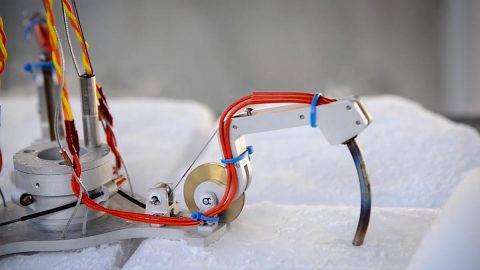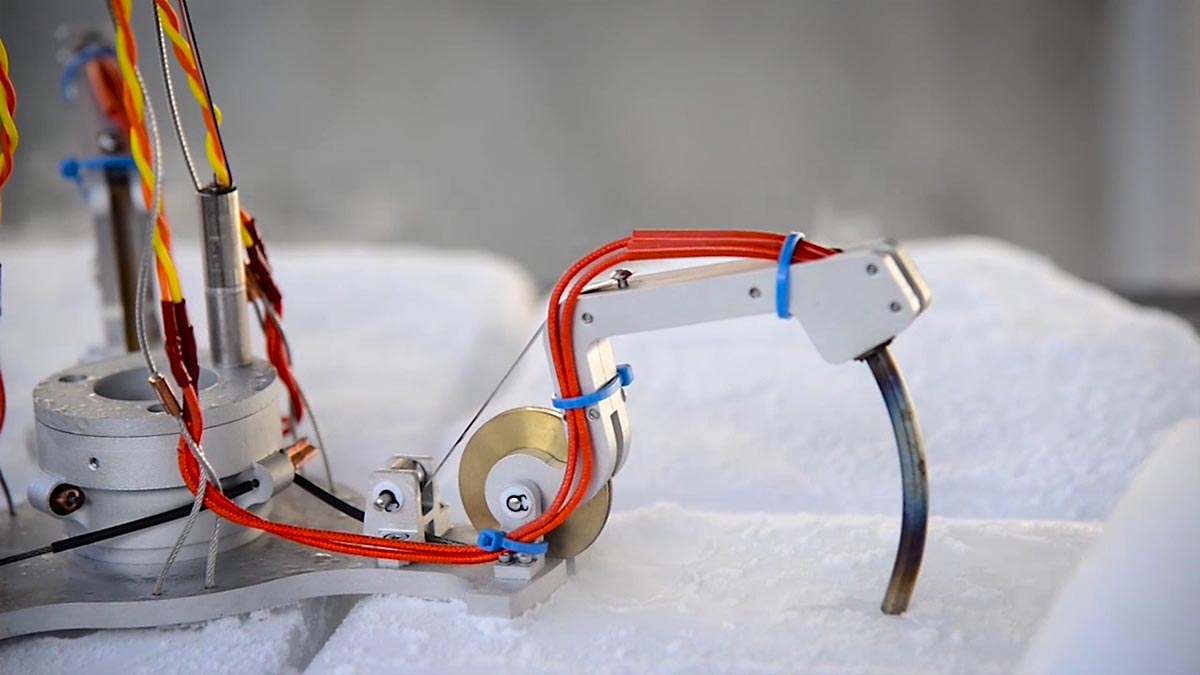Written by Andrew Good
NASA’s Jet Propulsion Laboratory
 Pasadena, CA – Want to go ice fishing on Jupiter’s moon Europa? There’s no promising you’ll catch anything, but a new set of robotic prototypes could help.
Pasadena, CA – Want to go ice fishing on Jupiter’s moon Europa? There’s no promising you’ll catch anything, but a new set of robotic prototypes could help.
Since 2015, NASA’s Jet Propulsion Laboratory in Pasadena, California, has been developing new technologies for use on future missions to ocean worlds. That includes a subsurface probe that could burrow through miles of ice, taking samples along the way; robotic arms that unfold to reach faraway objects; and a projectile launcher for even more distant samples.

“In the future, we want to answer the question of whether there’s life on the moons of the outer planets — on Europa, Enceladus and Titan,” said Tom Cwik, who leads JPL’s Space Technology Program. “We’re working with NASA Headquarters to identify the specific systems we need to build now, so that in 10 or 15 years, they could be ready for a spacecraft.”
Those systems would face a variety of challenging environments. Temperatures can reach hundreds of degrees below freezing. Rover wheels might cross ice that behaves like sand. On Europa, surfaces are bathed in radiation.
“Robotic systems would face cryogenic temperatures and rugged terrain and have to meet strict planetary protection requirements,” said Hari Nayar, who leads the robotics group that oversaw the research. “One of the most exciting places we can go is deep into subsurface oceans — but doing so requires new technologies that don’t exist yet.”
A hole in the ice
Brian Wilcox, an engineering fellow at JPL, designed a prototype inspired by so-called “melt probes” used here on Earth. Since the late 1960s, these probes have been used to melt through snow and ice to explore subsurface regions.
The problem is that they use heat inefficiently. Europa’s crust could be 6.2 miles deep or it could be 12.4 miles deep (10 to 20 kilometers); a probe that doesn’t manage its energy would cool down until it stopped frozen in the ice.
Wilcox innovated a different idea: a capsule insulated by a vacuum, the same way a thermos bottle is insulated. Instead of radiating heat outwards, it would retain energy from a chunk of heat-source plutonium as the probe sinks into the ice.
A rotating sawblade on the bottom of the probe would slowly turn and cut through the ice. As it does so, it would throw ice chips back into the probe’s body, where they would be melted by the plutonium and pumped out behind it.
“We think there are glacier-like ice flows deep within Europa’s frozen crust,” Wilcox said. “Those flows churn up material from the ocean down below. As this probe tunnels into the crust, it could be sampling waters that may contain biosignatures, if any exist.”
To ensure no Earth microbes hitched a ride, the probe would heat itself to over 900 degrees Fahrenheit (482 degrees Celsius) during its cruise on a spacecraft. That would kill any residual organisms and decompose complex organic molecules that could affect science results.
A longer reach
Researchers also looked at the use of robotic arms, which are essential for reaching samples from landers or rovers. On Mars, NASA’s landers have never extended beyond 6.5 to 8 feet (2 to 2.5 meters) from their base. For a longer reach, you need to build a longer arm.
A folding boom arm was one idea that bubbled up at JPL. Unfolded, the arm can extend almost 33 feet (10 meters). Scientists don’t know which samples will be enticing once a lander touches down, so a longer reach could give them more options.
For targets that are even farther away, a projectile launcher was developed that can fire a sampling mechanism up 164 feet (50 meters).
Both the arm and the launcher could be used in conjunction with an ice-gripping claw. This claw could someday have a coring drill attached to it; if scientists want pristine samples, they’ll need to bore through up to eight inches (about 20 centimeters) of Europa’s surface ice, which is thought to shield complex molecules from Jupiter’s radiation.
After deployment from a boom arm or a projectile launcher, the claw could anchor itself using heated prongs that melt into the ice and secure its grip. That ensures that a drill’s bit is able to penetrate and collect a sample.
Wheels for a cryo-rover
In July, NASA will mark a 20-year legacy of rovers driving across Martian desert, harkening back to the July 4th, 1997 landing of Mars Pathfinder, with its Sojourner rover.
But building a rover for an icy moon would require a rethink.
Places like Saturn’s moon Enceladus have fissures that blow out jets of gas and icy material from below the surface. They’d be prime science targets, but the material around them is likely to be different than ice on Earth.
They tested lightweight commercial wheels fixed to a rocker bogey suspension system that has been used on a number of JPL-led missions.
The next steps
Each of these prototypes and the experiments conducted with them were just starting points. With the ocean worlds study complete, researchers will now consider whether these inventions can be further refined.
A second phase of development is being considered by NASA. Those efforts could eventually produce the technologies that might fly on future missions to the outer solar system.
This research was funded by NASA’s Space Technology Mission Directorate’s Game Changing Development Program, which investigates ideas and approaches that could solve significant technological problems and revolutionize future space endeavors.
Caltech manages JPL for NASA.
For more information on Ocean Worlds Europa Technologies, visit:
https://gameon.nasa.gov/projects-2/ocean-worlds-europa-technologies/



